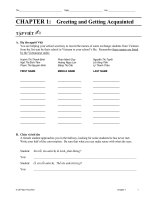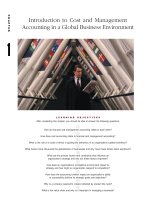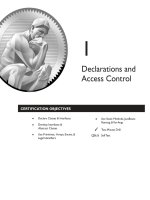Chapter 1: financial and accounting
Bạn đang xem bản rút gọn của tài liệu. Xem và tải ngay bản đầy đủ của tài liệu tại đây (116.84 KB, 14 trang )
Chapter 1
Accounting Information:
Users and Uses
Albrecht, Stice, Stice, Swain
COPYRIGHT © 2008 Thomson South-Western, a part of The Thomson Corporation. Thomson, the Star logo, and South-Western are
trademarks used herein under license.
1
LEARNING OBJECTIVES
• What’s the purpose of accounting?
• Who uses accounting information?
• What kind of environment does accounting
operate in?
• Why should I study accounting?
2
Food for thought
• You are running a grocery store. List 5 daily
important decisions you need to make?
• What information do you need to make the good
decisions? Where do you get it from?
3
How do you get the information?
4
Accounting
• Accounting is a system that provides
“quantitative information primarily financial in
nature, about economic entities that is intended
to be useful in making economic decisions.”
5
The Purpose of Accounting
• Accumulates financial data
– analyzing, recording, classifying, summarizing the
transactions of a business.
• Measures financial performance
– Profitability, efficiency, risks
• Communicates financial information
– Financial statements
Informed decisions can be made
6
Who Uses Accounting
Information?
Internal users (Management Accounting):
Management
– information needed for planning, implementing plans,
and controlling costs
Examples of reports:
•
– Budgets
– Cost analyses
– Performance reports
No standard reports
7
Who Uses Accounting
Information?
External users (Financial Accounting):
Investors
Lenders
Employees
Customers
Competitors
Government
Press
Suppliers
Examples of reports:
–
–
–
–
•
•
•
Balance sheet
Income statement
Statement of cash flows
Other regulatory reports
The outputs of MA help managers make informed decisions. How
about the outputs of FA?
Full and fair information for external users vs. Protection of sensitive
information
Standard reports to meet standard accounting rules
8
Rules of the Game
External Reporting:
• General accepted accounting principles (GAAP)
– Comparability
– Reliability
Internal Reporting:
• No rules
9
Who Makes All the Rules?
Generally accepted accounting principles (GAAP)
made by Financial Accounting Standards Board
(FASB)
– U.S. companies
• International Financial Reporting Standards
(IFRS) made by International Accounting
Standards Board (IASB)
– Most international companies
10
The Accounting Environment
Accounting Regulators
Financial
Accounting
Standards Board
(FASB)
Public Company
Accounting
Oversight Board
(PCAOB)
International
Accounting
Standards Board
(IASB)
Accounting
World
Security
and Exchange
Commission
(SEC)
Internal
Revenue Service
(IRS)
American
Institute of Certified
Public Accountants
(AICPA)
11
How much is 2 + 2 ?
• The engineer pulled out his slide rule and shuffled it back
and forth, and finally announced, "It lies between 3.98
and 4.02".
• The mathematician said, "In two hours I can demonstrate
it equals 4 with the following short proof.“
• The logician paused for a long while and then said, "This
problem is solvable.“
• The politician said, "I don't know the answer, but I ‘m
glad that we discussed this important question.”
• The trader asked, "Are you buying or selling?“
• The creative accountant , "What would you like it to be?“
12
Other Environmental Factors
• Ethics
– Professional judgment
– Enron: misrepresent the company’s performance by
keeping reported income and reported cash flow up,
asset values inflated, and liabilities off the books.
• Technology
– Vast amounts of information about transactions can
be stored
– Data can be compiled quickly and accurately
Will computers replace the accountant?
13
Why Should I Study Accounting?
Everyone makes financial decisions
Budgeting
y
u
B
v
g
in
Investing
g
n
i
s
a
e
s. l
F
n
a
in
g
n
ci
To make good financial decisions!
14









